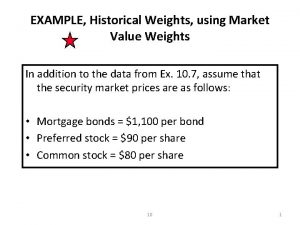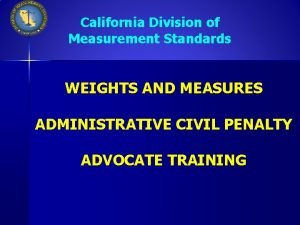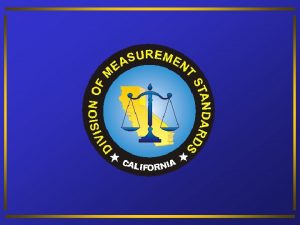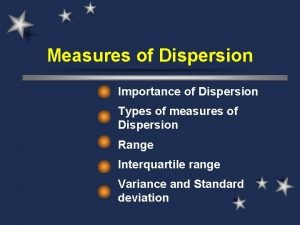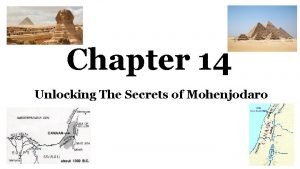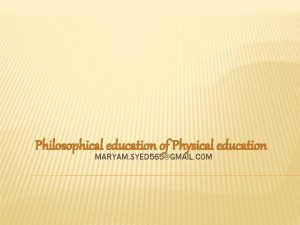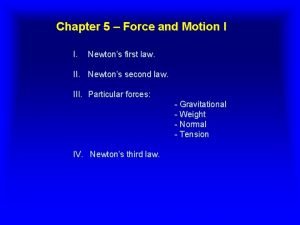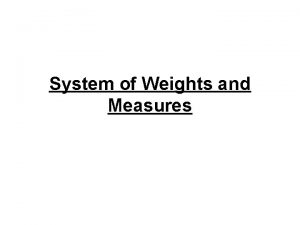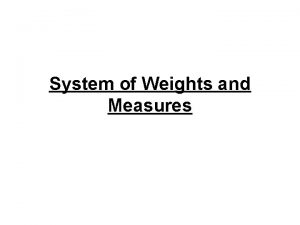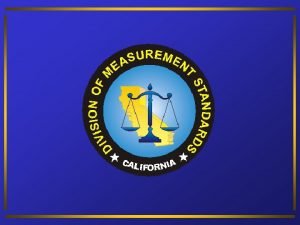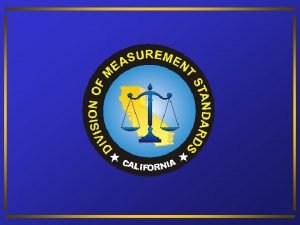WEIGHTS AND MEASURES WEIGHTS AND MEASURES Discuss where











- Slides: 11

WEIGHTS AND MEASURES

WEIGHTS AND MEASURES • Discuss where we might use different weights and measures in a kitchen? • Recipe ingredients!!

TYPES • May be in mass, volume or by count. • Dry ingredients usually measured by mass, e. g. 125 g flour • Liquid ingredients usually measure by volume, e. g. 125 ml milk • Foods such as meats or eggs are usually measured by count, e. g. 2 eggs.

IMPORTANCE OF FOLLOWING A RECIPE • What might happen if you don’t follow the recipe weights and measurements correctly? ? Discuss • It can have an affect on flavour. • It can affect taste. • It may affect aroma. • The dish may not be a success. • It could change cooking time required. • It could change the cooking method best suitable. Any more ideas?

WEIGHT CONVERSION

THE FOLLOWING ARE ALL EQUIVALENT TO APPROXIMATELY 25 g or 1 oz 1 level tablespoon Salt Approx. 25 g or 1 oz 3 level tablespoons Flour Approx. 25 g or 1 oz 2 level tablespoons Rice Approx. 25 g or 1 oz 5 level tablespoons Grated Cheese Approx. 25 g or 1 oz 4 level tablespoons Cocoa Powder Approx. 25 g or 1 oz 1 level tablespoon Honey/Syrup/Ja m Approx. 25 g or 1 oz 2 level tablespoons Granulated sugar Approx. 25 g or 1 oz 3 level tablespoons Sifted Icing Sugar Approx. 25 g or 1 oz 6 level tablespoons Fresh breadcrumbs Approx. 25 g or 1 oz

SPOONS SPOON MEASURES 1 Tablespoon (tbls) 3 Teaspoons 1 Desert Spoon 2 Teaspoons 1 Level Tablespoon (tbls) 15 ml 1 Level Teaspoon (tsp) 5 ml

EXPERIMENT • One half of the class is going to make some basic fairy cakes using a recipe with ingredient weights. They will follow this recipe using a weighing scale to measure out ingredients accurately. • The other half will be given the same recipe but will not be given any weighing scales. They will have to guess the quantities of ingredients needed to make the fairy cakes. • We will compare the results at the end.

FAIRY CAKES • Ingredients 100 g SR Flour 100 g sugar 100 g margarine 2 eggs. Method: 1. Weigh out the ingredients correctly. 2. Cream together the butter and sugar until light and fluffy. 3. Add the eggs and beat well. Add a small amount of flour if mixture curdles. 4. Fold in the flour. 5. Distribute into bun cakes and bake at 180 C for 20 minutes.

FAIRY CAKES • Ingredients SR Flour sugar margarine eggs. Method: 1. Weigh out the ingredients correctly. 2. Cream together the butter and sugar until light and fluffy. 3. Add the eggs and beat well. Add a small amount of flour if mixture curdles. 4. Fold in the flour. 5. Distribute into bun cakes and bake at 180 C for 20 minutes.

RESULTS • Compare the different appearances of the two different types of fairy cakes. • Complete a sensory analysis of the fairy cakes in your books. • Write a sentence explaining the importance of following a recipes weights and measurements accurately.
 Target weights vs historical weights
Target weights vs historical weights Tablespoon abbre
Tablespoon abbre Weights and measures training course
Weights and measures training course Fuller's formula for concrete
Fuller's formula for concrete California weights and measures
California weights and measures California weights and measures
California weights and measures Amateurs talk tactics professionals talk logistics
Amateurs talk tactics professionals talk logistics What is the importance of measures of dispersion
What is the importance of measures of dispersion Anova repeated measures
Anova repeated measures Unlocking the secrets of mohenjodaro
Unlocking the secrets of mohenjodaro He invented over 80 machines using pulleys and weights
He invented over 80 machines using pulleys and weights The two blocks a and b have weights
The two blocks a and b have weights
